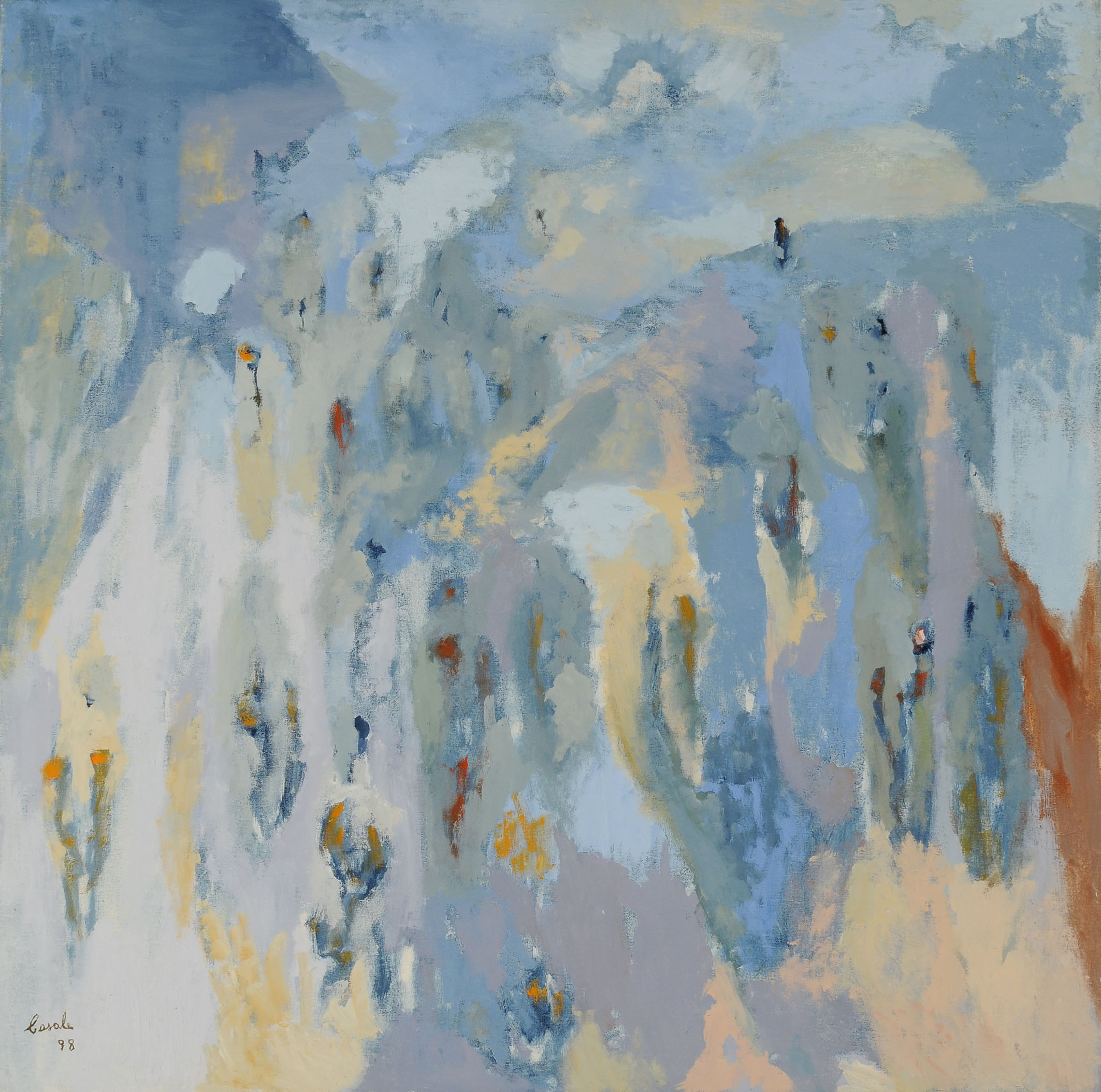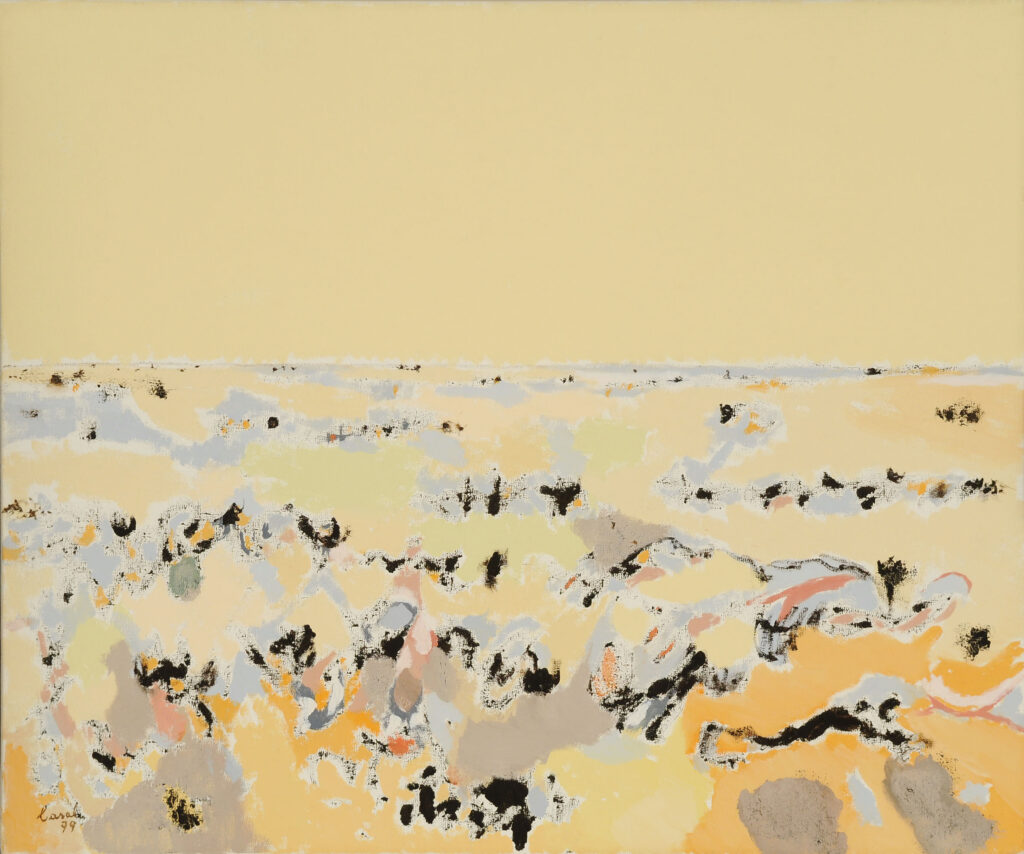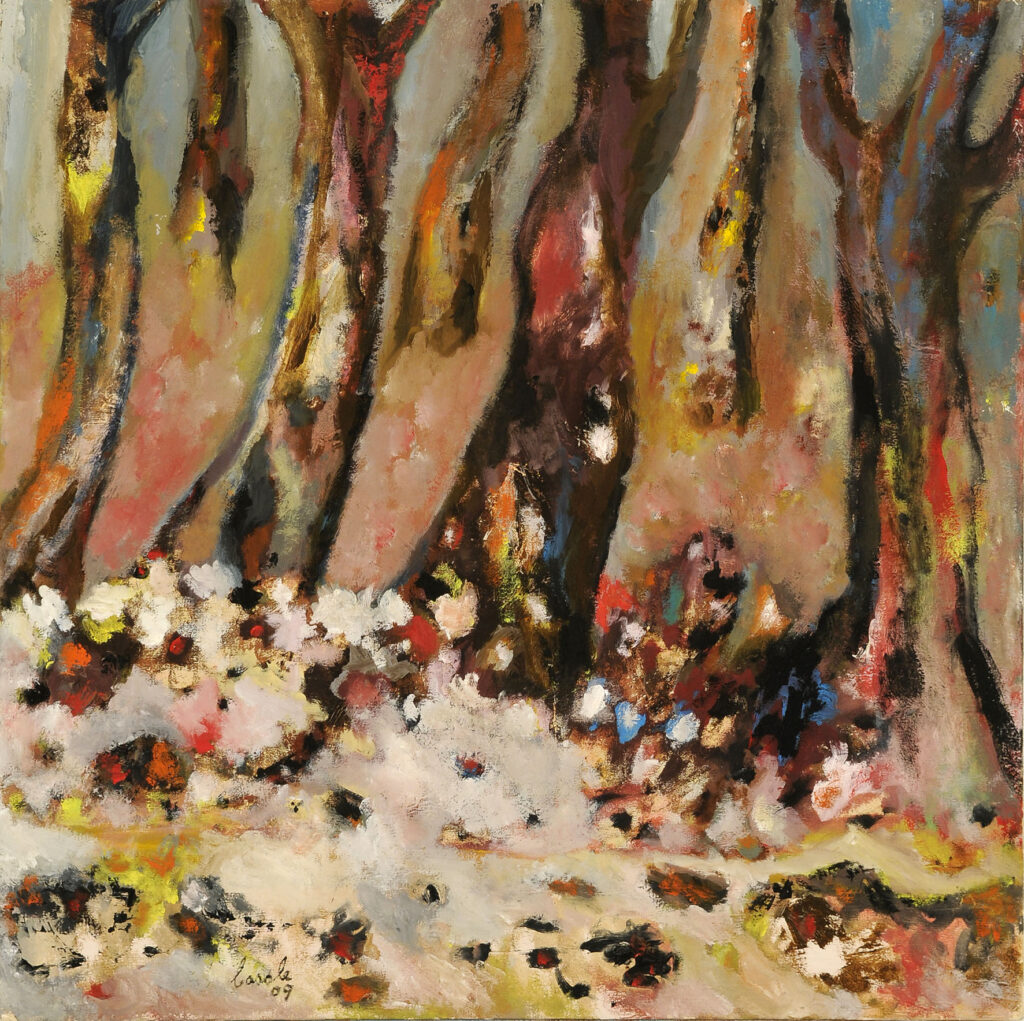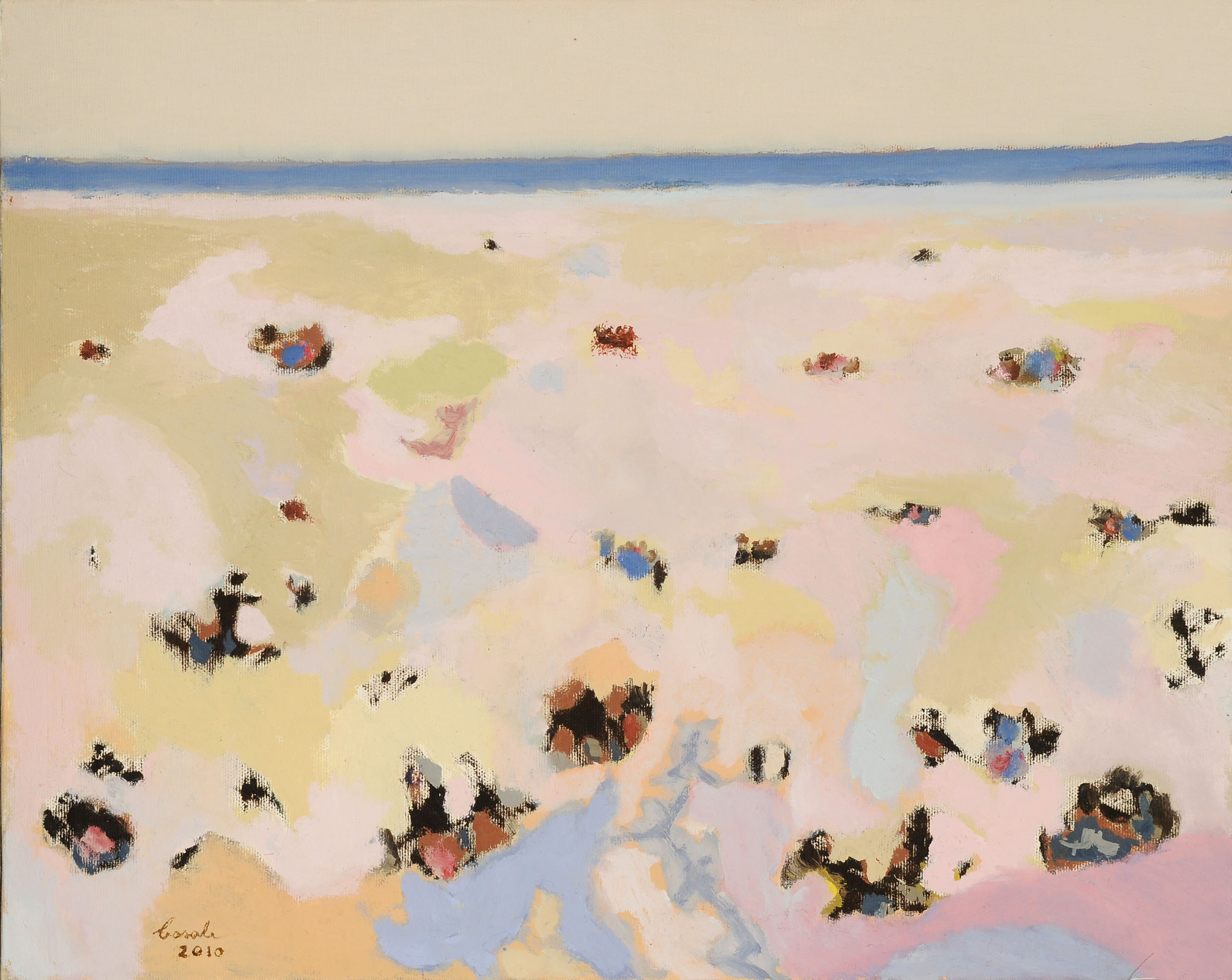
For Alessandro Casale, painting was a happy—and I believe, unexpected—landing, since he embarked on its practice at an age when the coordinates of one’s interests and vocations are already decidedly fixed, especially for someone who has consolidated a significant professional commitment—in his specific case, in the legal field—that is neither negligible nor always easily reconciled with the activity of painting. This is not to be understood as a mere pleasant pastime pursued with little or no ambition for research or worldly exploration—a simple leisure diversion conducted, perhaps, with the taste and sensitivity that are generally—though not invariably—found in well-cultured individuals.
This, however, is not the case with Casale. Rather, at the age of 35 he did “discover” painting as a vehicle—ideally sought long before—for the expression of certain intimate, expressive needs, for moods and emotions that demanded to be concretized into a poetic event. He then nurtured this unsuspected vocation with such continuity and diligent work that in a very short time he acquired not only a craft worthy of respect, but also the fundamental elements of a language that alone allow one to develop a true style.
One need only note that in very few years—from his early days (around ’68) to roughly ’73–’74—he established the technical–formal and genre fundamentals of his painting, later refining and increasingly aligning them to a lyrical purpose, having essentially identified them already after his first, rather scholastic attempts, carried out within the framework of a traditional Tuscan vedutism. In rapid succession, these early experiments were followed by experiences alternately characterized by a material emphasis with an expressionistic inclination (as in Nell’attesa, 1968) or by a tonal synthesism that sought to transcend the mere naturalistic–descriptive assumption through a clean application of paint (as in Albeggiare, 1969). Finally, with Balcone fiorito (’72), Sentiero di campagna (’73) and numerous other paintings of similar design—once the unity of the naturalistic vision had been fractured—Casale discovered the autonomous qualities of the pictorial fabric and of the color that nourishes and animates it with decorative suggestions, attributed both to the sumptuous quality of matter imbued with chromatic moods and to the phrasing of the à‑plat.

It is unnecessary to dwell further on the rapid enrichment of his previous figurative experience (practiced on the well-worn texts of the post–Macchiaioli Tuscan tradition) with a renewed visual culture—linguistically speaking, drawing on compelling sources from expressionism, symbolism, tachism, abstract–concreteness, informality and, to a certain extent, even the exquisitely Luccan—as in recent decades a local approach has emerged in conceiving landscape as an almost fantastical vision of territories cluttered with objects, which serve as pretexts for incisive pictorial notations and inventions of a refined narrative taste.
For our artist, then, it was a matter of suddenly opening himself to a painting of imaginative elaboration rather than a mere figurative transposition of the naturalistic given—a naturalistic datum he has never completely abandoned, the visual record still serving as a mnemonic device that coordinates the free chromatic signs and brings them into substantial congruence with the phenomenal world to which man is intimately and vitally bound.
The pictorial variations in this important formative period were numerous. Predominant are those compositions built from chromatic fragments with well-defined tonal values, with streaks that shatter the perspective framework into puzzle-like structures—in which the more fluid and articulated the compositional syntax appears, the freer and more imaginative the allusions to a central, inspiring reality become, even though it is not yet fully problematized, so to speak, as a lyrical–existential projecting space, as it will later evolve.
Verso la completa distruzione (’73) is the transitional painting that astonishes with stylistically and poetically novel intentions. The “ecological” allusion is expressed through the evident depiction of fish in decay on a beach strewn with biological debris and inorganic waste. Yet in this explicit acknowledgment of breakdown and culpable environmental alteration lies a thematic limitation of the work—its dating to an era of alarmingly belated denunciations in Italy compared to Carson’s bestseller Silent Spring (1962).
It is here important to underline the linguistic acquisition of the “color-sign”—that is, a highly dynamic formal element which, from now on, will characterize and emotionally qualify the image by animating every part with varying intensities of chromatic accentuation and material consistency, almost as if yielding to the motions of the soul triggered by the emergence of a clump of undergrowth or a stone from the sandy expanses, or by a flower of dazzling beauty amidst a profusion of light that whitens and confuses the forms.
Yet in Verso la completa distruzione the structure remains concrete—in other words, organized along decisive compositional lines: matter forms its solid, humoral component, so that one can speak of a “landscape of the soul,” even though the accumulation of stones, fish, and objects—displayed with abundant demonstrative force and a hint of recrimination—is then subjected to a process of pictorial disintegration that transforms things into patches, coagulations, and tears, effectively camouflaging them within the environment.
In this admirable painting it becomes clear that the intention is to imbue the landscape with a series of meanings and allusions—a subtle reference to an “other” psychological landscape, to the map of the soul which nature mirrors as its double. It follows naturally that the artist produces an image ideally recorded, in its stylistic and poetic peculiarities, in response to the inner urgencies and the philosophy of life he has developed through his personal experience of the world and of man.
It is appropriate here to emphasize the breadth of meaning that the term “landscape” assumes in Casale, who may have initially approached this genre by inertia—as many beginners do—but who quickly grasped the expressive possibilities of existential themes with a strong psychological impact, devoting himself to them almost exclusively.

Not that the Luccan artist has neglected other conventional pictorial subjects—from the figure to still life, which are usually concomitant with vedute—and indeed, several examples of fine craftsmanship and convincing aesthetic outcome are documented. In the overall body of his work, however, thematic excursions remain marginal. This is hardly a real problem, since even when Casale sketches the head of a little girl with an uncertain profile, appearing almost as a vapor in the background, with eyes sharp yet adrift in space (as in Figura, 1983); or when he annotates, in a tremulous segnico–chromatic “script,” the multifaceted and captivating fragrance of a bouquet (as in Fiori per mia madre, 1983), what invariably emerges is a landscape sui generis—a rediscovery of the rugged human or vegetal morphology in search of pulsating signs of life to be captured before they dissolve into nothingness.
In reality, Casale transcends the conventional boundaries of genres through his assiduous engagement with expanses deliberately chosen as laboratories for the mutations that matter and the forms of organic life undergo in the unceasing flow of time. Their variations in state and condition are rendered with delicate tonal transitions that, in his floral compositions, mark the gradual withering leading to the decay of petals and leaves, resplendent with vivid lifeblood and pigments.
Framed in these terms, I would even say that for Casale it is inappropriate to speak of landscape in the canonical sense—there are no appreciable margins of adherence to a fixed telluric reality, to any specific geographic localization, to a local color, or to a vedutistic tradition traceable to specific places (though, of course, every process of abstraction is always a transgression of the eventual naturalistic model).
What Casale paints is invariably an idea of landscape selected from among the thousand impressions that have left a trace in memory, the result of invention and formal simplification: an essential symbolic space in which “a stenography of the soul is inscribed”—to borrow an elegant image from Gastone Breddo; a visual enclosure, pictorially refined and trained to utilize even the slightest remnants of sensitivity, even the most fragile moods.
The transition from the simply fascinating and original painting Verso la completa distruzione to the landscapes of ’78, which realize a transformed pictorial vision, occurs through a gradual reduction of visual elements and compositional syntax. Space is defined by the elementary bipartition of the surface along the high horizon line (which often even disappears, yielding to aerial panoramas), while matter loses all its plastic corporeality, becoming a diffuse and transparent luminous veil that tends to dissolve forms into an indistinct fabric marked here and there by clumps, coagulations, filaments, and patches—almost like ignitions or inflorescences of atomized color.
Casale comes to perceive the deep breath of nature and its vital cycles by distancing the observer—not only in an optical sense, that is, by positioning himself at a distance that, by nullifying details (and, metaphorically, the relative, the contingent, the everyday), allows one to read the overall morphology and geological structure, the dominant and significant chromatic variations corresponding to the different qualities of soils and vegetation, as well as biological and climatic processes.
With this distancing, the order of issues related to the nature plundered by man also changes. Following the explicit “ecological” denunciation we encountered in Verso la completa distruzione, there now emerges an existential alarm—an indirect message conveyed through the inner consumption of matter—a process that is pictorially translated through the use of subdued hues, nearly to the point of monochromy, in atmospheres of brown, gray, pastel pink, and violet, all graduated with the skillful use of an entire range of midtones. On this modulated background, a concert of acute touches and variably defined sonorous timbres (at times rendered as the subtlest, most piercing signs, at other times as broad patches) qualifies the landscape, revealing its secret process of becoming—almost as if it were the physiological pulse in the succession of seasons and, with them, of climates and forms of life.
Whether composed of discrete notations or rendered in a sparse, almost liquid manner, whether it retains a more or less recognizable trace of sensible appearances, painting becomes a narrative of subdued elegy—a lyrical dialogue with a humanized and mirrored nature—so that the remnants (for instance, a fish in the process of fossil-like mutation as in Ultima spiaggia, 1978, or its re-assimilation into the morphology of a “landscape” of stones and sedimented sand) assume the value of a mute and strangely familiar document, warmly engaged as though it were a human story.
I have spoken of an intimate and subdued dialogue. The synesthesia of silences introduced by Casale’s landscape imagery will not escape notice. The technique of long fields and receding horizons, the aerial surveys of a compendious nature, and the supremacy of a total light inherent in and emanating from the matter (an unreal, filtering light that nullifies volumes and dissolves contours) are the formal elements that reconcile a Leopardi-like intuition of essences. To this intuition, silence is functional, nourished by distant voices and mysterious sounds perceptible through meditative contemplation. It is precisely through reflection that Casale has filtered and exalted the facile visual suggestions and immediate emotions, reducing the landscape to an ideal screen that reveals not the things themselves but their imprints. Thus, the particular placement of the image between naturalism and abstraction becomes clear, encompassing both the objective reference—though never in a banal imitative way—and the pure formal economy of colors and signs of autonomous expressive value.
A painting such as Fiori selvatici sulle Pizzorne (1983) is, in this sense, revelatory, as are Trasfigurazione di un paesaggio and Veduta aerea, since the relationship between objectivity and abstraction is maintained at a significant threshold of ambiguity. It must be said that Casale is not interested in reaching absolute aniconism, just as he is not attracted by mimetic exercises. In my opinion, his best works are those that, through the prism of ambiguity, unveil the transitional states from form to formlessness, from the timbral emergence of a color or clump of matter to the diffused tonality of atmosphere, from the revealed and manifested image to that which is suggested and intuitively reassemblable by each in the trace of a personal vision.
A generous measure of intimacy, abandonment, and memorial restitution thus appears as a consequence of Casale’s vocation and choices toward an evocative landscape capable of recording the emotional impulses and ever-changing moods of a soul sensitive both to laughter and to melancholy, open to life and the beauty of the phenomenal world while remaining reflective on the time that wears down and consumes everything—nature and the man who participates in its unfolding drama.
The predilection for silent expanses, stirred by imperceptible intervals between motion and stasis, finds its rationale in a reflective and contemplative temperament that is able to grasp the messages nature sends us, translating them into images of graceful figurative expression.
I feel compelled here to caution that at first, on a superficial inspection, Casale’s painting does not reveal its full semantic depth—especially in his more recent works, which have lightened further in tonal values and lost material consistency, almost to a diaphanous lightness—since it is entrusted to a formal repertoire that might be described as impoverished, or rather extremely simplified, and that repeatedly returns, with relentless iteration, to the pictorial motif and the horizontal schema (to which other subjects such as houses, figures, and objects—also referable, as mentioned, to the theme of landscape—are not exempt).
It is necessary, in this regard, to emphasize that it is precisely in this technical–formal exhaustion and in the gentle obsession with the long pictorial sequence that the singular stylistic and poetic authenticity of Casale’s work is patiently composed in his quiet Lucchese retreat.
This is a work that one must approach with a corresponding “simplicity” of spirit—that is, by allowing oneself to engage in the visual apprehension (or, one might say, the auscultation) of the smallest morphemes that reproduce on the canvas the secret vibrations of the soul. One will then grasp the ductility of a language that, though seemingly monotonous, is in fact played upon subtle textural and atmospheric variations.
For instance, one cannot fail to notice the progressive dematerialization to which the image is subjected through the lightening of paint layers and the thinning of touches, until it reaches dissolutions almost resembling an ethereal dream (Serenità di una visione, 1982) or a dazzling luminous glare (Marina d’estate, 1983) that are a step away from abstraction, situating themselves in the realm of pure lyrical imagination—a notion also evoked by the subtlety of hues already noted by Dino Pasquali and attributed to a chiaroscuro area. In contrast, paintings executed with more incisively evident textures always appear of delicate execution, on extremely contained tonal ranges, and are meticulously marked with a profusion of touches (Fiori selvatici, 1983), which impart an unusual animation to the overall composition.
In any event, rather than a strict naturalistic focus or a determination in terms of climate and latitude (such as the southern Italian beaches that belong to the artist’s affective geography), within the range of Casale’s pictorial formulations one can discern—again—an equal number of dispositions of the soul that call for appropriate expressive moments.
The measure of originality of these ideal landscapes—where the physical presence of man is excluded (since his troubled psychology is instead embraced)—lies in the authenticity of the emotional flow that inspires them and in the resonances they evoke in the observer. It is from this condition that the proper evaluation of the contents, to which the ineffable “stenography” of the Luccan artist alludes, must be derived; he is to be credited with having introduced a note of rare delicacy into a Tuscan landscape tradition that, on the contrary, is inspired by more concrete constructive principles aimed at structural solidity and density of matter.
Casale’s work confirms that, ultimately, landscape is a psychological category (and as such it resonates profoundly today) rather than a genre of old convention—a way of conceiving the narrow enclosure of the canvas as a window opened not only onto the world of nature but also onto the soul, which is an inseparable dimension of nature. In keeping with his lyrical inclination, Casale has developed a cipher of spaces, signs, and colors that is both agile and coherent—a language that rightly demands its own semantic and stylistic placement within contemporary Italian painting, and in particular within Tuscan art, which is committed to reconciling the figurative tradition with the contributions of modern research, especially in terms of materiality and aniconism.

NICOLA MICIELI
